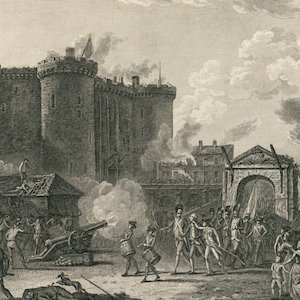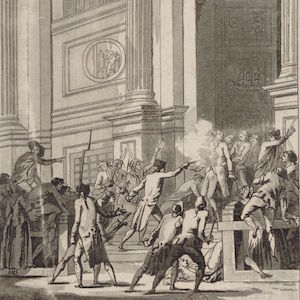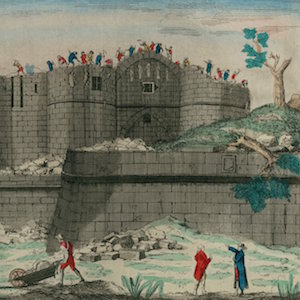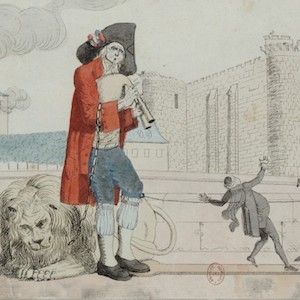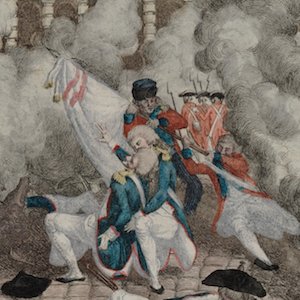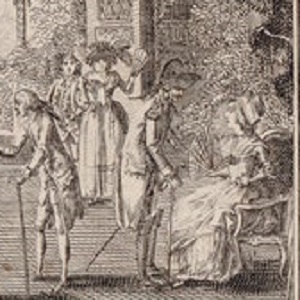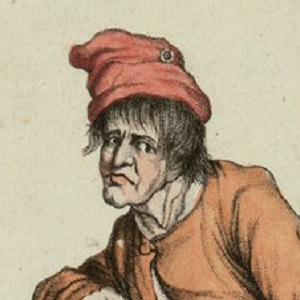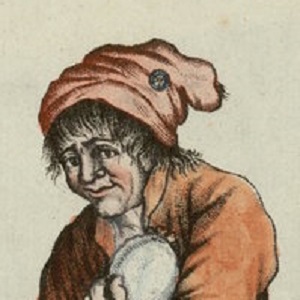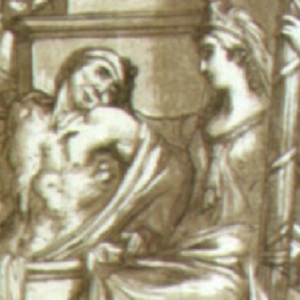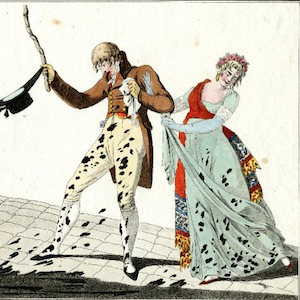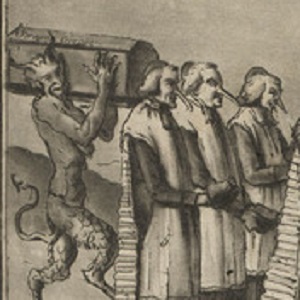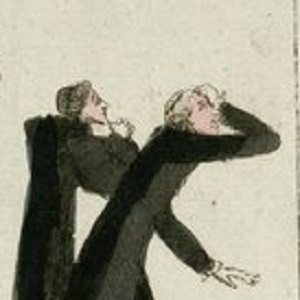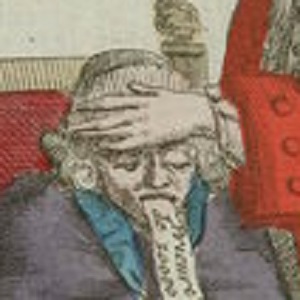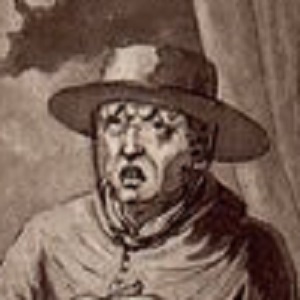Source Collection: Paris and the Politics of Rebellion
Overview
The world was shocked by the swiftness and strength with which radicalism emerged in the first years of the Revolution. Interestingly, it is not so surprising that throughout the two centuries that have elapsed since then, labor has remained mainly arrayed on the political left. But was this an inevitable circumstance of the French Revolution? Could Parisian workers, tied as they were to service and consumer industries, not have been more loyal to the rich, who could pay them well? Self-interest might have pushed them in a direction entirely different from the one they took. In the event, circumstances conspired to give the popular classes of Paris an inordinate amount of political influence at a time of ferment in the nation's history. The vision of these most idealistic, perhaps truest believers in the Declaration of the Rights of Man and Citizen, might best be understood not as a utopian dream or violently resentful opposition to property owners, but as a nascent and imperfectly formed, but broad and vibrant, theory of an open and democratic society.
This source collection includes an informational essay and 95 primary sources.
Essay
The working people of Paris decisively entered into formal politics through the French Revolution. Concentrated in the eastern part of the city, near the Bastille and in the neighborhood of Saint-Antoine, artisans and laborers were the industrial backbone of the capital. They toiled in small shops of usually less than twenty workers composed of masters, journeymen, and apprentices. Though known to historians as "workers," they actually varied broadly in their levels of education and wealth. At the upper levels of this range were those who came to lead the popular movement. They were fairly well educated and well-off but also depended upon many with middle-class backgrounds—the journalists and lawyers—who most aggressively took up the political cause of "the people." Exactly what percentage of the entire working population took up politics as well as which elements of the populace predominated remain the focus of debate. Without seeking to resolve these thorny questions, this chapter focuses on the politics that related visibly to the urban artisans and their allies. This is then the story of those who acted as the populace, whatever their precise social standing. Whereas Chapter 1 showed the "people" as a social group of sans-culottes, here they are seen directly affecting the course of the Revolution—through their daily activities, their great moments of protest, and their discussions of morality, politics, and the economy. As the documents attest, contemporaries considered them a violent, potent force.
Even before 14 July 1789, the Parisian "crowd"—as some contemporaries and many historians refer to the politically active populace—found protest and even violence an effective means to voice its desires to its members and to the rest of society.
Needless to say, the people made their most dramatic entrance onto the revolutionary stage with their seizure of the Bastille. The atmosphere in mid-July had already grown quite tense, as the Estates-General—meeting in Versailles twenty miles away—had been thwarted in a number of its initiatives by the King, and rumors circulating in the capital suggested that royal troops were preparing to disband the assembly. On 12 July, Parisians also learned that the popular finance minister Jacques Necker had been dismissed. It is difficult to know how the populace interpreted these developments and what role they played in the uprising of 14 July: Was the protest that led to the taking of the Bastille a conscious political reaction intended to protect the Estates-General against royal interference, or, given the sharply rising bread prices in Paris at the time, were the crowds that gathered on the 14th engaging in a more traditional form of protest, a large-scale "bread riot," that took on political significance only as events unfolded? Certainly, in the days prior to the 14th, some Parisians called on the people to mobilize and prevent a royal or "aristocratic" attack on the nascent Revolution. Most famously, the journalist Camille Desmoulins rose on a soapbox before a crowd assembled on the 12th in the public gardens of the Palais-Royal to urge "the people" to take action.
Throughout the next three days, crowds gathered to protest the high bread prices; royal troops sent to quell any disturbance instead fraternized with the demonstrators. On 14 July they allowed—even helped—a group looking for arms with which to take over the city search the royal veterans' hospital, but without success. At the same time, another crowd was swarming around the Bastille, a medieval royal fortress that loomed above the workers' neighborhoods at the eastern edge of the city. Lightly armed, but still impregnable to the thronging crowd, the Bastille could have held out longer, but when the threat to their position seemed to be increasing, its defenders did not really have the stomach for a fight and lowered the drawbridge, allowing the crowd into the courtyard. As a result of a miscommunication, the troops fired a volley into the crowd trapped within the outer walls, setting off a pitched battle that culminated in the commander's surrender, capture, and rapid beheading.
Though many people remained uncertain about the meaning of the day's events, the radical press immediately proclaimed the fall of the Bastille a successful blow to despotism. As the radical press increased the vehemence and volume of its reports, this interpretation soon emerged as the predominant one, and across Europe, especially in Versailles, the storming of the Bastille was portrayed as an immense defeat for absolutist authority. Ironically, as a fortress the Bastille served little purpose, and the seven inmates freed on 14 July included no actual victims of political oppression. But the taking of the Bastille had great significance to the people, who made clear their sense of triumph soon thereafter by leveling the building, an act that symbolized the felling of despotism. Images justified and recorded this sense of outrage.
Fired up by the events in Paris, people mounted insurrections in twenty-eight of the largest thirty cities in France throughout the summer of 1789. In response to these movements and peasant mobilizations in the countryside, the National Assembly decreed the abolition of feudalism on 4 August and proposed the Declaration of Rights of Man and Citizen in August. However, the King resisted these actions. Moreover, word spread among the people of Paris that royal soldiers attending a party at Versailles had trampled the tricolor cockade, as a gesture of opposition to the Revolution. Enraged, populist radicals promised a response, of which the 14th had only been the beginning. To add to the atmosphere of crisis in Paris, bread prices remained perilously high. Under the weight of these pressures, market women initiated a protest in the marketplace and then decided to march to Versailles and bring the King to Paris as a means of safeguarding the Revolution and guaranteeing the supply of bread. As they set off, National Guard soldiers, commanded by Lafayette, joined in, hoping to prevent violence. Upon arriving at Versailles, the crowd issued demands to the King and then occupied the palace overnight until the royal family descended and agreed to return to Paris. Soon thereafter, Louis, now based in the Tuileries Palace, consented to sign the Declaration of the Rights of Man and Citizen, and again, it seemed the people's intervention had pushed the Revolution forward.
Over the next two years, Parisian workers did not take to the streets in the same numbers and with the same broad goals as they had in the middle of 1789. Nonetheless, tensions continued to mount as the radical press harped on the many problems that were still unresolved, and the workers remained poised for direct action. Radical political discourse directed hostility not only toward the King, but also toward the lawyers and other "bourgeois" who led the National Assembly, the Commune of Paris (that is, the new municipal government installed after the insurrection of 14 July), and the National Guard. By the summer of 1791, these bodies—formerly seen as instruments of the Revolution—had become the targets of ever more protests. After Louis XVI tried unsuccessfully to escape the country on 21–22 June 1791, Parisian radicals demanded a national referendum on what to do next, because the newly drafted constitution did not give the National Assembly the authority to depose the King.
The ensuing debate over the fate of the King and the constitution itself came to a head at the Federation Festival of 14 July 1791, when patriots demonstrating on the Champ de mars (parade ground) in favor of a republic were attacked by the Paris National Guard. The radical press issued an immediate call for aggressive action and in the following months continued to press the people of Paris to defend themselves and their revolution. The following summer, Parisian artisans demonstrated just such aggression in a series of demonstrations that culminated in an attack on the Tuileries Palace on 10 August 1792. It ended with the arrest of the royal family and the dispersal of the Legislative Assembly.
Having liquidated the national government and created a temporary power vacuum, radical activists focused their attentions on the Paris Commune, an administrative body over which they could exercise disproportionate influence through public pressure. Amid this unrest, foreign forces drew closer to Paris, with a careful eye on the internal resistance that now seemed to be posing a threat to the Republic. Tensions in the capital reached new heights and finally overflowed in September 1792 in a violent massacre of thousands of political prisoners. Even the most extreme commentators denounced these "September Massacres" as excessively violent.
In this fevered fall of 1792, elections were held for a new Constitutional Convention (a legislature that would not have to share power with an executive authority) that would rule France as an interim government while preparing a new, republican constitution. When the National Convention met several weeks later, it was deeply divided over how to proceed. On one side were the Jacobins, a group that believed they had been elected to carry out the will of the people, through decisive action; on the other side were the Girondins, a faction no less committed to the Revolution but bent on creating proper decision-making mechanisms to guard against the public's passions of the moment. At first the latter group, led by Jean-Pierre Brissot, dominated the debate. It had the support of other, less activist deputies referred to as "the Plain" (because they sat in the lower, central section of the Convention's meeting hall). The Girondins were drawn primarily from mercantile, provincial cities such as Bordeaux and had been the same men in control of the just-dispersed Legislative Assembly. Thus they held no great sway among the populace of Paris, who considered the Jacobins more responsive to their demands for lower bread prices, the more rapid sale of confiscated church lands, and a more democratic government.
Over the next few months, the parliamentary leadership faced constant criticism from the more radical faction of deputies in the Convention (known as "the Mountain" because they sat in the higher seats, to the left of the rostrum), as well as the radical press and sans-culottes in the sectional assemblies. The Mountain included Jacobins and members of other important clubs. In early 1793 several divisive decisions cost the Girondins much of their following in Paris: their opposition to the execution of the King, their support for General Charles-François Dumouriez (who defected to the enemy), their efforts to stabilize the currency by slowing the resale of confiscated lands, and their opposition to regulating grain markets to bring down bread prices in the capital. On each measure, the Mountain proved unrelentingly critical in its speeches and press, until finally, on 31 May 1793, the people of Paris—led by the Cordelier Club and other radical orators who had inspired many sectional assemblies—broke the deadlock by surrounding the Convention's meeting hall and demanding the expulsion of the Girondins. Even though the radicals in the Convention hesitated before complying with such extra-parliamentary direct violence, they offered no real resistance. After three tense days, the crowd succeeded in shifting leadership in the Convention to the more radical deputies.
The radicals' direction of the government gave new strength and force to the popular movement in Paris, as the militants in the sections now perceived themselves to be responsible for saving the Republic from its enemies, both foreign and domestic. The Convention's deputies took a different view, worrying that the continual tumult in the streets could render the country ungovernable. Yet they could do little to address this concern because of the continuing threat of civil and foreign wars. Only after that peril diminished could the Mountain begin to deal with the enormous influence of the Parisian popular movement. In late 1793–94 the leaders of the Convention (organized in a "Committee of Public Safety") silenced their most active popular supporters in Paris. The Committee arrested and executed such radical club leaders as Jacques-René Hébert and Jacques Roux and shut down the sections that had provided the organizational basis for the sans-culottes. Even so, Maximilien Robespierre and his collaborators on the Committee of Public Safety remained popular with Parisian artisans and laborers, although the workers became increasingly disillusioned and disorganized and less able to function as a powerful political force. Finally, on 9 Thermidor Year II (27 July 1794), capitalizing on a split within the ruling Committee of Public Safety, former supporters of the executed revolutionary orator Georges Danton and radicals disappointed with current directions in the committee persuaded the Plain to reject Robespierre's strident advocacy of judicial terror as a means of ruling the country and acted to depose the Mountain. Robespierre and his followers no longer could look for a mobilization of sans-culottes in the streets or for the press to intimidate their foes into silence. The artisans would rise again during the revolutionary decade, but never to the same degree and certainly not with the same success as before.
Popular political activism consisted of more than just the great journées (day-long demonstrations), of course; workers attended sectional and club meetings. Whereas the earliest "clubs" had drawn educated professionals to debate leading questions of the day, the sections were more popular and activist bodies. Although the Parisian sections exercised only limited power at first, they gained considerable strength as centers of dissent, which made successive revolutionary legislatures fear them. During the Revolution's most radical months, from September 1793 to July 1794, when the Committee of Public Safety controlled the Convention, the sections of Paris declared themselves in "permanent session" and assumed local administrative direction of the Terror, exercising political and juridical functions at the neighborhood level. To encourage participation by workers, the radical leaders of the Convention—at Danton's behest—paid people a stipend to attend sectional assemblies. Only in late 1793 did the Convention reverse course and seek to weaken these bodies.
In these dramatic months, sans-culottes also had their own clubs and participated in such formerly bourgeois clubs as the Jacobins and especially the Cordeliers, which became leading voices for artisans and provided a direct link between the working people of Paris and the Mountain's deputies in the Convention. In the early years of the Revolution, clubs also provided an important venue where women—excluded throughout the period from full citizenship rights—could participate in Revolutionary politics. When the Convention acted to limit popular radical political activism in late 1793, however, it repressed women's clubs with particular ardor. Contemporary views of popular participation in clubs varied, with supporters defending them as instances of popular democracy and as schools of constitutional procedure and critics attacking them as artificial and divisive centers since they distracted the people from their true allegiance to the "nation."
The crowd attacked enemies and lionized friends, such as the journalist Jean-Paul Marat. Swiss-born, Marat was a ne'er-do-well scientist who had attempted much but achieved little in the old regime. The Revolution opened up an opportunity that he seized by publishing his explosive newspaper, L'Ami du Peuple (The Friend of the People). A staunch supporter of the rights of working people, Marat argued that sovereignty ought to belong to the nation. Communities ought to exercise very careful control over their representatives, whose powers ought to be heavily restricted.
In Marat's political imagination, the poverty of the artisans had removed them from greed, which left them not only pure, but highly intelligent. As a propagandist, Marat was without peer; as a politician, he had few direct successes. Yet the Girondins feared and loathed him and tried to expel him from the Convention in the spring of 1793. Their failure exposed their lack of popular support and led to a radical backlash, culminating in the coup of 31 May–2 June, an event in which Marat played a leading role by naming those deputies who should be arrested. For a few weeks thereafter, confined by a debilitating skin disease to his bathtub, Marat pressed the most radical causes of the Revolution in particularly vitriolic fashion in the Ami du Peuple until Charlotte Corday assassinated him. Thus martyred, Marat became for many an unblemished revolutionary hero who embodied the Revolution's virtues and whose wounds could be invoked to justify the violence of the Terror against its domestic enemies. By contrast, opponents of the Mountain and of the sections represented Corday as the virtuous martyr who dedicated herself to her people's salvation.
Radicals found another great hero in "the Incorruptible" Maximilien Robespierre, who from the very beginning of the Estates-General had spoken for popular causes. During the Terror, he took the leading role in the government as the commanding presence on the Committee of Public Safety, from which he dominated the Convention and successfully fought off challenges from the left and right, until his execution on 9 Thermidor.
Popular political culture also generated a number of antiheroes, generally social types rather than particular individuals. After a brief period of immense personal popularity, Louis XVI was represented in increasingly abstract and scornful terms. Well after the assassination of the former King, known as "Citizen Capet," the "aristocracy" remained a particularly hated word in the revolutionary lexicon, connoting more broadly all political opponents of "the people," not just those designated as "heretofore nobles," who themselves also came in for scorn. Finally, the clergy served regularly as a target of radical attacks, as vaguely anticlerical sentiments voiced in 1789 became outright antipathy. Widespread clerical resistance to the Civil Constitution was taken to be proof of indifference and even opposition to the cause of the Revolution and the people. By the most radical phase of the Revolution, popular political leaders were attacking not just refractory priests, but the entire church establishment, as well as Christianity in general.
Although popular political activists expressed multiple goals, which shifted over time, the impact of "the people" on the Revolution had become clear by the fall of 1793—it had overthrown the monarchy, propelled its allies (the Mountain) into power in the Convention, and helped instigate the Terror and the Law of Suspects. In part, these actions had an economic goal: the Maximum was enacted in the fall of 1793 to limit prices and to prevent unfair profiteering while ensuring the provisioning of Paris and of the armies. After all, the high price of bread had surely been a powerful motivation for Parisian workers to become politically active in 1789, and they remained intensely suspicious of unfair merchant profits. Moreover, radicals found immoral the idea that "speculators," "profiteers," and "hoarders" could pursue personal interest amid the crisis of the Revolution and forsake the high ideals of Liberty, Equality, and Fraternity. Such a redefinition of public morality found its spokesperson in Robespierre, who wanted to ensure that the new government would be a "republic of virtue." In the late winter of 1794 he was willing to go so far as to enforce this virtue through the Terror, if necessary.
By 1794 even the Mountain had begun to doubt the efficacy of price controls, and all French revolutionary regimes after Thermidor would consistently toe the line of economic liberalism. Nevertheless, popular politics clung to the view that limiting profits and prices was an essential part of the revolutionary program, as is clear from the popular uprising of the spring of Prairial, Year III (May 1795), which occurred after the fall of Robsepierre. By this time, the balance of power had shifted away from Parisian artisanal activists, however, and the uprising was rapidly and forcefully repressed by the central government.
The world was shocked by the swiftness and strength with which radicalism emerged in the first years of the Revolution. Interestingly, it is not so surprising that throughout the two centuries that have elapsed since then, labor has remained mainly arrayed on the political left. But was this an inevitable circumstance of the French Revolution? Could Parisian workers, tied as they were to service and consumer industries, not have been more loyal to the rich, who could pay them well? Self-interest might have pushed them in a direction entirely different from the one they took. In the event, circumstances conspired to give the popular classes of Paris an inordinate amount of political influence at a time of ferment in the nation's history. The vision of these most idealistic, perhaps truest believers in the Declaration of the Rights of Man and Citizen, might best be understood not as a utopian dream or violently resentful opposition to property owners, but as a nascent and imperfectly formed, but broad and vibrant, theory of an open and democratic society.
Primary Sources
Credits
From LIBERTY, EQUALITY, FRATERNITY: EXPLORING THE FRENCH REVOLUTION, https://revolution.chnm.org/exhibits/show/liberty--equality--fraternity/enlightenment-and-human-rights




